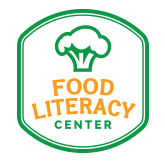A Child’s Year in Food Literacy
One year ago, we began food literacy classes at Capitol Heights Academy, a school for K-5thgrade kids from low-income families. When we arrived, 82% of the children told us healthy food didn’t taste good. In a school where the vast majority of these kids are on free and reduced lunch plans, we know that learning a healthy lifestyle is paramount.
Childhood obesity is a leading public health concern that disproportionately affects low-income and minority children. Children who are obese in their preschool years are more likely to be obese in adolescence and adulthood.
It’s much easier to teach a child a good habit than to help an
adult break a bad one. So we start young. When kids are taught
about healthy choices, they’re more likely to grow up to be
health-conscious adults, but just as importantly they’ll help
their parents, teachers and our communities to be healthier,
too.
In the classroom, we try to use familiar recipes to help children
learn how easy and tasty it is to make healthy changes. One of
our signature lessons involves making a peanut butter
sandwich—and we substitute apple slices for jelly. Kids learn
that apple slices have fiber and vitamins. Jelly doesn’t.
Last year, when we taught this lesson, we started by watching a video of a child making a peanut butter and apple sandwich.
“Ew!” our students proclaimed as she announced the ingredients in her lesson. Last year, any time we introduced a foreign ingredient, our kids were hesitant. Yet, by the end of the lesson, each student was crying, “Can we eat our sandwiches yet?!”—each eager to taste their own recipe creations.
Fast forward one year. A few weeks ago, we repeated our peanut butter and apple sandwich recipe with this year’s group of food literacy students. Some of the students attended our classes last year. Some are new.
As the kids filed in for class, they started raising their hands before they even sat down.
“I know what we’re going to make today!” they each exclaimed.
“What?” I asked.
“Peanut butter and apple sandwiches!” they beamed. “That was my favorite class last year!”
This time, when we showed the video of the girl making her sandwich, the children laughed and asked us to rewind it. No one said, “Ew.”
Last year, when we passed around the slices of wheat bread, our students held the pieces with the tips of their fingers, afraid. This year, as soon as we opened the packages the children breathed deeply inward.
“It smells so good!” they cried, and each student raised from their seats, eager for a chance to stick their nose close to the bag and smell the rich, yeasty bread.
In fact, our now-brave eaters added not only apple slices to their sandwiches, but also kiwis that the school had on hand. They stuffed their sandwiches full, asking for second and third helpings of fruit.
After several weeks of making subtle changes to familiar foods, like adding apples slices instead of jelly to a sandwich, we decided to introduce some new recipes to our healthy eaters. We brought in local farmers from Feeding Crane Farms, equipped with beautiful, leafy chard. We also prepped carrots, lettuce, cilantro, and brown rice.
We passed these ingredients down the row of children, allowing them to take as much of each ingredient as they liked. Little hands reached greedily for heaping handfuls of lettuce, hearty pinches of grated carrots, and plenty of cilantro. The farmers walked by and passed out tastes of chard—the children’s first. Several children popped it in their mouths raw, while others mixed it carefully into their rice.
Our volunteers could hardly keep up with the demands for more!—more!—more! When it comes to vegetables, the children’s wishes are our command.
I caught one volunteer with her jaw opened, watching in amazement as our children gobbled their salads without even a nudge.
Beautiful chard from Feeding Crane Farms.
After class last week, we sent the children home for their long holiday break with bags full of fruits and vegetables. They aren’t likely to find these fresh goodies at home, and we know how much they love eating them!
We laid out several boxes of freshly picked tangerines and told the children they could take extras—as many as they liked. Moms wiggled over to help. Dads stood on the sidelines, nudging, “Take 2 more! Take 2 more!” Children strained under the weight of their beautiful, overflowing grocery bags.
We allowed each child to take home one item from a “grab box” of random, unmatched produce. One little girl dug patiently through it.
“Cherries!” a volunteer said. “What about those?”
The little girl shook her head. “No.” She dug deeper into the box.
“She loves broccoli,” her father said from behind her.
“Here’s some!” The volunteer waved a heavy head of green in front of the girl.
“Yes!” she cried, brushing the sticky sweet cherries aside, swiping the broccoli florets from the volunteer’s hand, and grinning ear to ear.
Today, when you ask our students if healthy food tastes good nearly 100% of them say yes. And then they ask for seconds. And thirds! This is a habit they will carry with them for good. One year of food literacy classes—that’s all it took.
YOU, our community, make this grassroots work possible. Thank you!
May your 2013 be filled with many chard smiles!
Article by Amber Stott.
Photos courtesy Kristin Thebaud.




